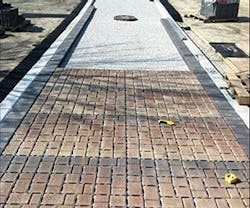Are you gasping for air amidst a flood of stormwater fees? More than 400 cities and utility districts nationwide now utilize parcel-based stormwater billing practices based on a property’s impervious area.
The fee could potentially increase hundreds or thousands of dollars annually compared to the previous system that based stormwater fees on potable water usage measured by the meter.
Implementing stormwater management practices (SMPs) is the only way to avoid this increased cost. And unless you have an area for landscaping or space for a large cistern, porous pavement may be one of your only options.
How It Works
Porous pavement – also called permeable or pervious – can be concrete, asphalt, and brick or block pavers. It is simply a surface with a pattern of voids to allow water to infiltrate.
“The water then passes through, but you have to plan for it to go somewhere,” says Steven D. Schmidt, PE, vice president of pavement, and senior consultant for consulting firm Benchmark. “There is usually another porous rock layer or an underground pool beneath the system that allows for retention. It needs to collect before it passes into native soils below.”
Applications for this type of system should be low traffic and without strenuous load bearing requirements. Typically a porous material won’t cover the entire lot. For instance, parking spaces may feature it instead of drive paths.
“Using it in certain areas is becoming commonplace,” Schmidt says. “At a manufacturing facility in southeast Wisconsin, we converted a landscape island in the center of the lot into porous pavement. It corrected drainage and snow pileup issues.”
Cost and Incentives
Porous pavement is not a possible alternative in all situations, Schmidt warns. Consider the location’s traffic and climate before making a decision.
“You pay a premium for a porous system,” he explains. “If the conditions aren’t right, it drives up costs further.”
However, there are incentives available to help offset costs. The new fees are designed to encourage owners to manage stormwater on-site. Sites that have implemented SMPs can earn utility bill credits or discounts to reduce their fees.
“The point is to incentivize people to minimize the impact they have on sewer infrastructure,” says Gary Belan, director of the Clean Water Program at American Rivers, a non-profit dedicated to keeping American waterways clean.
The Green Values National Stormwater Management Calculator from the Center for Neighborhood Technology, a non-profit in Chicago, can help you assess the feasibility and cost effectiveness of a porous pavement project. It is available at greenvalues.cnt.org/calculator.
Success Story
In Milwaukee, a parcel-based billing program was introduced in 2006 at $6 per 1,610-square-foot unit per quarter and is now $14.40. There, a General Mills plant was paying $12,000 annually.
The plant opted for a porous pavement system to capture runoff from the 2-acre area, resulting in an annual savings of $3,000.
American Rivers can help you find grants to assist with upfront cost, says Belan, adding that it did so at the Milwaukee plant. As you compute these fees and figures, it’s important to stay calm.
“Don’t panic. The fee comes as a bit of a shock, and there’s a knee-jerk reaction to these types of things. But given the way infrastructure is crumbling, municipalities need additional resources,” Belan says.
“Keep an open mind. Work with local municipalities because they’ll have suggestions,” Belan adds. “If they’re implementing the fee in the first place, they just want to keep water out of the system. They’ll be happy to work with you to reduce your impact.”
Chris Curtland is assistant editor of BUILDINGS.
